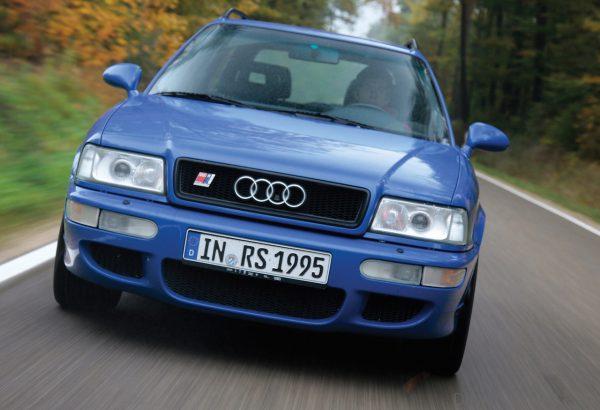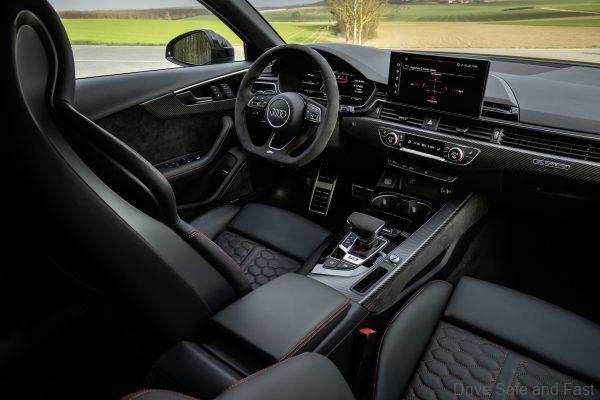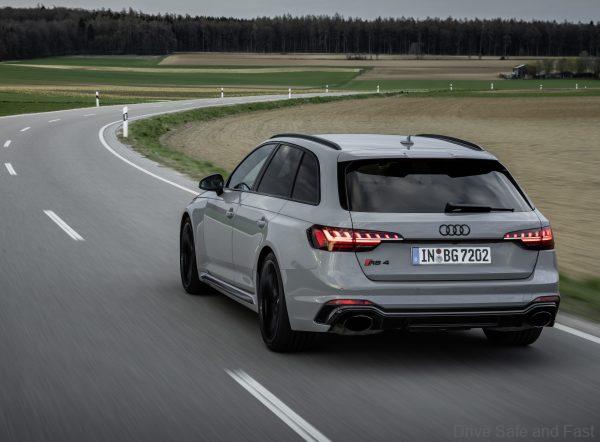Audi RS 4 Avant Is Now In Singapore At SG404,075
What About Malaysia? We have the roads to exploit this RS!
Audi in Singapore has just done a virtual launch of their high performance sports wagon the RS 4 Avant. The RS Avant range started some 26 years ago with the RS 2 Avant which provided sports car performance with five seats and a very useable luggage area.
Under the bonnet was a 2.2-litre turbocharged five-cylinder engine that delivered an impressive 315hp allowing this Audi RS2 Avant family wagon to accelerate from 0-100km/h in just 5.4 seconds and hit a top speed of 262km/h. To make sure this car stopped in time, its braking system and wheels came from Porsche.

Now, this latest 2020 Audi sports wagon, the RS 4 Avant delivers 450hp from a V6 engine of 2894cc which allows it to accelerate from 0-100km/h in just 4.1 seconds. This is just 1.3 seconds faster than its 1994 parent.

PRESS RELEASE: Audi RS 4 Avant is now at the Audi Centre Singapore
Audi Singapore has launched the latest updated version of the RS 4 Avant. The newly designed front section and the sporty interior with the new MMI touch operating system underline the athletic capabilities of the success model, which has a legendary line of ancestors. The high-torque twin-turbo V6 with a power output of 331 kW (450 hp) applies an impressive 600 Nm of torque to the crankshaft in a broad engine speed range from 1,900 to 5,000 rpm. The Audi RS 4 Avant is now available at the Audi Centre Singapore with a recommended retail price of S$404,075 including COE and VES.

Muscular: the exterior design
The front section of the new RS 4 Avant has been completely redesigned. The RS 4 Avant differs considerably from the A4 Avant. The Singleframe is wider and flatter as compared to the base model, and is designed without a frame to give it a clean look. The RS 4 Avant also features the three-dimensional honeycomb structure in gloss black that is typical for the RS model series. The new eggcrate grille with the RS 4 emblem is inserted directly into the bumper with the large lateral air inlets and vertical flaps.
The shape of the LED headlights of the RS 4 Avant has also been redesigned. The optional matrix LED headlights with darkened bezels complete the revised appearance of the high-performance Avant and differentiate it within the A4 family. The wheel arches with the quattro blisters located above are each 30 millimeters wider at the front and back as compared to the Audi A4 Avant. Gloss black design elements positioned right next to the headlights underline the effect of width of the new RS 4 Avant.
The gloss black, matt aluminum and carbon styling packages add individual accents to the inlay in the sill, the exterior mirror housings and the front and rear bumpers. The RS-specific roof edge spoiler, diffuser insert and the tailpipes of the RS exhaust system give the vehicle a distinct finish.
On request, the car can be specified with the RS sport exhaust system which features black tailpipe trims and creates a particularly sporty sound experience. Customers can decide whether they want a sporty or subdued sound via the Audi drive select dynamic handling system.





Full tractive power: the drive
With the 2.9 TFSI twin-turbo V6, Audi Sport GmbH is building on the legendary 2.7 liter V6 of the first RS 4 Avant from 1999. Back then, the twin-turbo V6 had a power output of 279 kW (379 hp). The new RS 4 Avant now outputs 331 kW (450 hp), which equals an output of 155.5 metric hp per liter. This allows the RS 4 Avant to accelerate from zero to 100 km/h in just 4.1 seconds.
The TFSI engine weighs just 182 kilograms, which is 31 kilograms less than the V8 engine in the predecessor model from 2012. This benefits the gross weight and the axle load distribution — two prerequisites for the impressive performance. The twin-turbo V6 applies an impressive 600 Nm (442.5 lb-ft) of torque to the crankshaft in a broad engine speed range from 1,900 to 5,000 rpm. The RS dynamic package increases the electronically governed top speed from 250 to 280 km/h.
The two turbochargers of the 2.9 TFSI are each assigned to a cylinder bank and build up a boost pressure of up to 1.5 bar. The turbochargers are installed within the 90-degree interior “V” of the cylinder banks, and thus the exhaust side of the cylinder heads is on the inside, while the intake side is on the outside of the engine. This layout enables compact construction and short gas flow paths with minimal flow losses, allowing the 2.9 TFSI to respond particularly spontaneously to movement of the accelerator pedal. The high-output V6 impresses not only with its strong performance but also with its high level of efficiency.
The technical package delivers a consumption reduction of 17 percent over the previous V8 model. A decisive factor in this is the new TFSI combustion process from Audi, which is known as the B-cycle. It has been specifically designed for the partial-load range, which is the predominant operating mode during normal use.
The power of the 2.9 TFSI flows to the quattro permanent all-wheel drive system via the sporty eight-speed tiptronic. In regular driving, the system delivers more power to the rear axle. The purely mechanical center differential directs 60 percent of the torque to the rear axle and 40 percent to the front. If undesired slip occurs at one axle, most of the power is automatically and rapidly redirected to the other axle — up to 70 percent to the front or up to 85 percent to the rear axle. The high locking values enable a clearly defined torque distribution and highly precise interaction with the control systems of the ESC and wheel-selective torque control.
Wheel-selective torque control is active on all types of surfaces. When driving with a sporty style, it brakes the wheels on the inside of the curve very slightly via the Electronic Stabilization Control (ESC), thereby increasing the drive torque on the wheels on the outside of the curve with the higher wheel load. The difference in drive forces turns the car into the bend, allowing the car to follow the steering angle precisely. The result: precise, agile and neutral handling. The quattro sport differential with RS-specific tuning (standard for Singapore) ensures an even more dynamic response when accelerating in corners. It distributes the torque between the rear wheels actively and in a targeted manner, thereby improving traction, stability and dynamics. When turning or accelerating in a curve, the torque is predominantly steered toward the rear wheel on the outside of the curve — the car is literally pressed into the curve, eliminating even the slightest hint of understeer. In case of oversteer, the sport differential stabilizes the vehicle by directing torque to the wheel on the inside of the curve.
Sporty tuning: the suspension
The axle concept of the suspension with five-link suspensions at the front and rear enables the optimal absorption of longitudinal and lateral forces. With the standard RS sport suspension, the Audi RS 4 Avant is seven millimeters lower than the S4 base model with sport suspension.
The optional RS sport suspension plus with Dynamic Ride Control (DRC) enables even more agile handling. This integrated roll and pitch stabilizer consists of a special damper system that counteracts the movements of the vehicle body with no delay without the use of electronics. When the vehicle is turning into and traveling around a bend, the damper response is altered so that the vehicle’s movements around the longitudinal axis (roll) and around the transverse axis (pitch) are significantly reduced. The highly responsive damper system ensures that the RS models are particularly precise when negotiating bends. With the aid of Audi drive select, the driver can influence the damper response on three levels. The new generation of dampers with integrated valve is more compact and lighter. In addition, it enables the damping forces to be spread even more widely between the comfort and dynamic modes as well as more precise suspension adjustment for high damping forces, which occur when cornering at speed in particular. The result: The RS sport suspension with Dynamic Ride Control (DRC) ensures a markedly comfortable rolling motion in the “comfort” setting. In the “dynamic” program, it delivers extraordinarily taut driving precision even when cornering at high speed.
RS-specific dynamic steering is available as an alternative to the standard electromechanical power steering. Dynamic steering varies the steering ratio by up to 100 percent based on the driving speed, steering angle and selected mode in the Audi drive select handling system. The level of power assistance is also high, making parking maneuvers a piece of cake. When driving at high speeds on the highway, the indirect gear ratio and low level of power assistance smooth out jerky steering movements and assist with confident directional stability. Dynamic steering works closely with the electronic stabilization control program (ESC) to achieve sporty handling and driving safety. The driver can create their personal driving experience via the standard Audi drive select dynamic handling system. There are five profiles available: comfort, auto, dynamic and the customizable, RS-specific RS1 and RS2 modes. The Audi drive select dynamic handling system influences the engine and transmission management, power steering, suspension, dynamic steering, quattro sport differential, engine sound and the characteristics of the automatic air conditioning.
Connected cockpit: the interior
The Audi RS 4 Avant features a black interior. LED light guides trace the contours of the doors and the center console — doing so in up to 30 different colors in combination with the ambient lighting package which comes standard for Singapore. The horizontal alignment of the instrument panel creates a sense of spaciousness. The driver and front passenger are welcomed by the illuminated door sill trims that bear the RS 4 logo.
The 10.1-inch MMI touch display is the control center of the new operating system. It is located in the center of the instrument panel and tilted slightly toward the driver. The touch sensitive screen displays a high-resolution graphic animation of an RS 4 Avant to welcome the driver, and also provides acoustic feedback and takes over the functions of the previous rotary pushbutton on the center console. The driver can use the RS monitor to call up an overview of drive system component temperatures, maximum g-forces and information regarding tire pressures and temperatures. In the Audi virtual cockpit, special RS displays provide information on tire pressure, torque, power output, engine oil temperature, lap timings, acceleration measurements and g-forces. The head-up display also provides some RS-specific information such as the shift light display. The menu structure of the new operating system is tailored to the user’s expectations and aims for easy operation. The natural language control translates phrases used in everyday language into commands. Navigation in the new RS 4 Avant is now even more versatile and user-friendly. Audi connect provides a host of online services.
The driver can actuate the two RS1 and RS2 modes in Audi drive select directly via a new “RS MODE” button on the flat-bottomed RS multifunction sport leather steering wheel. This automatically opens the RS-specific displays in the Audi virtual cockpit. The new aluminum shift paddles are considerably larger than before. Aside from the steering wheel and the illuminated door sill trims, the RS sport seats with honeycomb pattern and the shift gate also bear the RS emblem.
Versatile: the equipment
The RS 4 Avant provides the same level of everyday usability as the A4 Avant base model. The luggage compartment has a capacity of 495 liters, which increases to 1,495 liters with the rear seats folded down and cargo loaded to the roof. The luggage compartment lid and the luggage compartment cover are electrically operated as standard. Sensor control for opening and closing the luggage compartment lid is available as an option, and a trailer towing hitch that can be unlocked electrically at the push of a button is also available upon request.
Customers of the RS 4 Avant can select from eight paint colors, including the new plain color Turbo blue and the new metallic color Tango red. The Audi exclusive program also includes many more customized paint finishes, for example Nogaro blue, pearl effect. This color already characterized the RS 2 Avant as the legendary forefather of all RS models back in 1994.
Legendary: the history
The new Audi RS 4 Avant stands for the combination of high-performance and everyday usability. Its line of ancestors dates back 25 years, to 1994, when the legendary RS 2 Avant was released.
1994 – Audi RS 2 Avant: Strong trendsetter
Audi set a strong trend with the RS 2 Avant in 1994: It was the world’s first high-performance sports car with five seats and a large luggage compartment. The distinctive exterior design and the fine interior with its two-color look and blue Alcantara seats helped shape its style. The five-cylinder turbo squeezed 232 kW (315 hp) out of 2.2 liters of displacement, accelerated the Audi RS 2 Avant from a standstill to 100 km/h in 5.4 seconds, and reached a top speed of 262 km/h. Porsche AG supplied parts such as brakes and wheels in its capacity as development and production partner.
1999 – compact displacement and high performance in the first generation
Cosworth Technology Ltd, which was integrated in the company shortly before, came into the picture as a cooperation partner for the first RS 4 Avant. Together with quattro GmbH, the English company made the 2.7 liter twin-turbo V6 with 279 kW (379 hp) even more powerful and torquey. The efficiency was also improved considerably thanks to larger intercoolers that were optimized for pressure loss. The RS 4 was thus designed for pure sportiness without sacrificing any of its everyday usability. It was in such high demand that Audi doubled the originally planned production figures.
2005 – Audi RS 4: Dynamics in three variants
The second generation of the RS 4 was launched in 2005. It was first released as a sedan and Avant and was later also available as a cabriolet. In terms of drive, it was equipped with the newly developed V8 high-revving engine with 4.2 liters of displacement. The direct injection engine had an output of 309 kW (420 hp), allowing speeds of up to 8,250 rpm to be reached. Further technology highlights included the quattro drive with the asymmetrical dynamic torque distribution at a ratio of 40 percent at the front and 60 percent at the rear, which was new at the time, and the optional carbon fiber ceramic brakes.
2012 – Audi RS 4 Avant: The dynamic all-purpose vehicle
In February 2012, quattro GmbH presented the third generation of the RS 4, which was offered as an Avant exclusively, at the Geneva Motor Show. Just like its predecessor, the model was equipped with a 4.2 l V8 high-revving engine but with an increased output of 331 kW (450 hp).
The Audi RS 4 Avant is now available at Audi Centre Singapore with a starting recommended retail price of S$404,075 inclusive of COE and VES.














